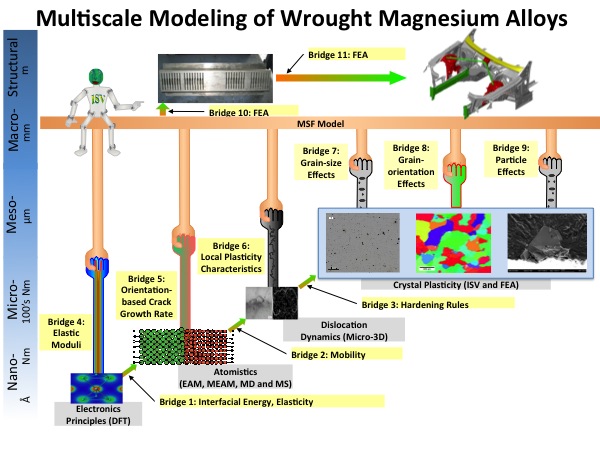Integrated Computational Materials Engineering (ICME)
ICME Overview for Wrought Magnesium Alloys
Downscaling Approach
In order to reduce weight in automotive applications, wrought magnesium alloys such as AM30 and AZ61 have begun to see an increase in use for these purposes, such as structural components of a car chassis. As these new materials are being implemented, it is important to characterize their fatigue responses. These fatigue characteristics can be broken down into a multiscale fashion, as illustrated in the following figure

Figure 1. Mutliscale approach to modeling wrought magnesium alloys.
Nanoscale
In order to understand the requirements needed to fully characterize the material, it is important to downsize from the structural scale. At the smallest scale is the nanoscale. Density functional theory can be applied here to gather information regarding the interfacial energy and elastic parameters of the material. Atomistic simulations such as those performed by Tang et al. [1] can then use this information in order to establish fatigue crack growth rates that are based upon crystallographic orientation for magnesium materials.
Microscale/Mesoscale
On the microscale, dislocation mobility from these atomistic simulations can then be used by Micro-3D calculations in order to understand the hardening effects for crystal plasticity. From here, microstructural features are observed via scanning electron microscope (SEM) imaging. Using image analysis of these images, information such as grain size, particle size, and particle nearest neighbor distances can be quantified for the extruded magnesium material microstructure [2][3]. This work by Jordon et al., along with additional studies by Bernard and colleagues [4], have begun to characterize the structure-property relationships for these wrought materials by conducting cyclic fatigue tests. By comparing fatigue life to microstructural information such as grain size, particle size, and grain orientation, a better understanding of the overall fatigue life effect can be gained for these materials. Other experiments involving replication of notched specimens [5] have shown the effects that crystallographic orientation have upon fatigue crack growth rates.
References
1. T. Tang, S. Kim, M.F. Horstemeyer, Fatigue crack growth
in magnesium single crystals under cyclic loading: Molecular dynamics
simulation, Computational Materials Science, 48 (2010) 426-439.
2. J.B. Jordon, J.B. Gibson, M.F. Horstemeyer, H.E. Kadiri, J.C. Baird,
A.A. Luo, Effect of twinning, slip, and inclusions on the fatigue anisotropy of
extrusion-textured AZ61 magnesium alloy, Materials Science and Engineering: A,
528 (2011) 6860-6871.
3. S. Begum, D.L. Chen, S. Xu, A.A. Luo, Strain-Controlled Low-Cycle
Fatigue Properties of a Newly Developed Extruded Magnesium Alloy, Metallurgical
and Materials Transactions A, 39 (2008) 3014-3026.
4. J.D. Bernard, J.B. Jordon, M.F. Horstemeyer, H.E. Kadiri, J. Baird, D. Lamb,
A.A. Luo, Structure–property relations of cyclic damage in a wrought magnesium
alloy, Scripta Materialia, 63 (2010) 751-756.
5. J.D. Bernard, J.B. Jordon, M. Lugo, J.M. Hughes, D.C. Rayborn, M.F.
Horstemeyer, Observations and Modeling of the Small Fatigue Crack Behavior of
an Extruded AZ61 Magnesium Alloy International Journal of Fatigue, (In Press).
